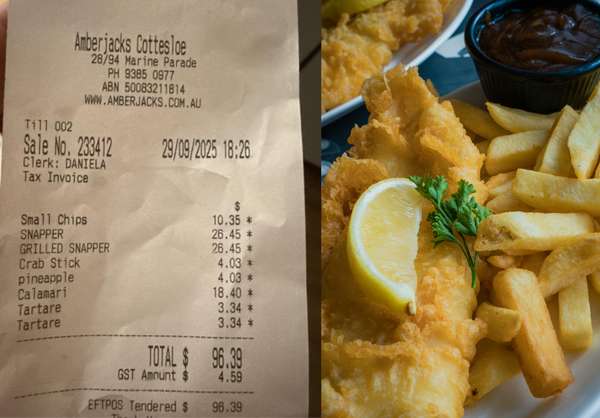
The humble fish and chips, once Australia's most affordable family meal, has become a symbol of the nation's cost-of-living crisis. With prices now reaching $30 or more for a basic serve in some locations, many seniors are finding their favourite Friday night treat increasingly out of reach.
Recent reports from across the country paint a concerning picture. A customer in Port Douglas, Queensland, was shocked to pay $28 for a single piece of flathead with chips, while Melbourne diners regularly face bills exceeding $25 for what was once considered working-class comfort food. These price hikes are hitting seniors particularly hard, especially those relying on the Age Pension.
In this article
The Numbers Don't Lie: A Pricing Crisis
Australia's beloved fish and chips have experienced price increases that far outpace general inflation. According to industry data, the average cost of fish and chips has risen by approximately 40 per cent over the past three years, with some areas seeing even steeper increases.
Current Fish and Chips Prices Across Australia
- Sydney CBD: $25-$35 for fish and chips
- Melbourne inner suburbs: $22-$30
- Brisbane: $20-$28
- Perth beachside: $24-$32
- Regional towns: $18-$25
For seniors who remember paying $5 for a generous serve in the 1990s, these prices represent more than just inflation—they signal a fundamental shift in affordability. The Australian Bureau of Statistics reports that food prices have increased by 7.5 per cent in the past year alone, but fish and chips have outpaced even this alarming trend.
Why Are Prices Skyrocketing?
The dramatic price increases aren't simply profiteering by shop owners. Multiple factors have created a perfect storm of rising costs that are passed on to consumers.
Supply chain disruptions continue to affect the fishing industry, with fuel costs for trawlers remaining elevated. The price of diesel, essential for fishing vessels, has increased by over 30 per cent since 2021. Additionally, climate change impacts have affected fish stocks, with some popular species becoming scarcer and more expensive to source.
Key Cost Drivers for Fish and Chip Shops
Wholesale fish prices up 45 per cent since 2021
Commercial rent increases averaging 15-20 per cent
Electricity costs doubled in many areas
Cooking oil prices increased by 60 per cent
Minimum wage increases of 5.2 per cent annually
Shop owners also face mounting pressure from energy costs, with commercial electricity rates making deep fryers expensive to operate. Many traditional fish and chip shops, often family-run businesses, are struggling to stay afloat without passing costs to customers.
Case in Point: Perth’s $100 Fish and Chips
Nothing illustrates the crisis more vividly than a recent viral incident in Perth’s upmarket Cottesloe. A diner shared a receipt from Amberjacks, a boutique fish and chip shop overlooking the beach, showing a total of $96.39 for two fish and chips with a few sides.
The order included two snapper fillets priced at $26.45 each, calamari for $18.40, small chips at $10.35, a crab stick and pineapple fritter at $4 each, plus tartare sauce at $3.34 per tub. A 15 per cent public holiday surcharge also applied, though it wasn’t itemised separately.
'WTF? $100 for two fish and chips and a couple of sides.'
Outrage quickly followed online, with many calling the prices 'daylight robbery' and 'extortion.' One commenter quipped, ‘That fish must have been caught in the crystal waters of Atlantis to cost that much.’ Others pointed out the sting of paying over $10 for a small serve of chips and more than $3 for tartare sauce.
But not everyone agreed. Some defended the shop, noting its prime location in one of WA’s wealthiest suburbs. ‘Dude went to the priciest part of town, chose the fish shop next to the most iconic beach in Perth… it’s hardly surprising,’ wrote one. Another added, ‘It’s about a $25 premium, which given the location and overheads, is probably fair.’
Still, for everyday Australians—especially seniors on fixed incomes—the debate highlights the growing divide between iconic traditions and their affordability in 2025.
The Impact on Australian Seniors
For many Australian seniors, fish and chips represent more than just a meal—they're a connection to simpler times and a traditional Friday night ritual. The affordability crisis is forcing difficult choices.
'I used to treat my grandkids to fish and chips every school holidays. Now it costs me over $100 to feed the family. I just can't afford it anymore.'
Nutritionists note that fish provides essential omega-3 fatty acids particularly important for aging hearts and minds. When seniors can no longer afford this traditional source of lean protein, their health may suffer. The social aspect is equally important—sharing fish and chips has long been a way for grandparents to connect with younger generations.
Regional Variations: Where to Find Better Value
Not all areas have seen equal price increases. Savvy seniors are discovering that location makes a significant difference to their fish and chips budget.
Coastal towns with direct access to fishing fleets often offer better prices, though tourist hotspots can be exceptions. Towns like Lakes Entrance in Victoria and Ulladulla in NSW still offer reasonable prices due to their proximity to fishing cooperatives.
Example Scenario
- Best value locations: Port Lincoln (SA) - $15-20, Batemans Bay (NSW) - $16-22, Mooloolaba (QLD) - $18-24
- Areas to avoid for value: Sydney Harbour - $35+, Gold Coast tourist strips - $30+, Melbourne's St Kilda - $28+
Some fish and chip shops are introducing 'pensioner specials' on quieter weekdays, offering smaller portions at reduced prices specifically for seniors. These typically run Monday to Thursday and can save $5-8 per meal.
Smart Strategies for Seniors
While prices may be rising, there are ways for budget-conscious seniors to still enjoy their fish and chips without breaking the bank.[/p>
Timing is everything. Many shops offer lunch specials between 11am and 2pm, with prices often 20-30 per cent lower than dinner service. Some establishments also provide 'early bird' discounts before 5pm.
Did you know?
Did you know?
Many fish and chip shops will prepare half portions for single diners if asked. This isn't always advertised but can save considerable money while reducing food waste.
Share plates have become increasingly popular among senior groups. A large fish and chips order split between two or three friends can reduce individual costs while maintaining the social aspect of the meal.[/p>
Consider alternative fish varieties. While barramundi and snapper command premium prices, flake (shark) and flathead often provide excellent value. Some shops also offer 'catch of the day' specials using whatever fish is most readily available.[/p>
The Bigger Picture: Cost of Living Pressures
Fish and chips prices reflect broader cost-of-living pressures affecting all Australians, but particularly those on fixed incomes. The Reserve Bank of Australia notes that food inflation continues to outpace wage growth, creating real hardship for pensioners.[/p>
Government support measures have failed to keep pace with rising costs. While the Age Pension is indexed to inflation, the lag time means seniors are always playing catch-up with prices. The recent $20 fortnightly increase to the Age Pension barely covers one fish and chips meal in many areas.[/p>
Monthly Budget Impact for Seniors
- Weekly fish and chips in 2020: $60/month
- Weekly fish and chips in 2024: $100+/month
- Percentage of pension: increased from 4 per cent to 7 per cent
- Annual extra cost: $480+
Looking for Alternatives
Some seniors are adapting by exploring alternatives that provide similar satisfaction at lower costs. Fish finger sandwiches made at home can recreate some of the experience for a fraction of the price. Frozen fish portions from supermarkets, while not the same as fresh-cooked takeaway, offer protein at manageable prices.
Community groups are stepping up to help. Some RSLs and senior centres have introduced monthly fish and chips nights, using bulk buying power to offer meals at 2010 prices. These events also provide valuable social connection.[/p>
Budget-Friendly Fish Options for Seniors
Canned salmon or tuna: $2-4 per meal
Frozen fish fillets: $5-8 per serve
Fish finger meals: $3-5 prepared at home
Supermarket deli battered fish: $6-10
Supporting Local Businesses
Despite the price challenges, many seniors want to support their local fish and chip shops, recognising these small businesses as important community assets. Some shops are working with regular customers to find sustainable solutions.[/p>
Loyalty programs are becoming more common, with some shops offering every 10th meal free or providing percentage discounts for regular customers. Others have introduced 'subscription' models where seniors can pre-pay for monthly meals at a locked-in price.
The Future of Fish and Chips
Industry experts predict prices will continue rising, though perhaps at a slower rate. Sustainable fishing practices, while environmentally necessary, may further increase costs. However, innovation in aquaculture and fish farming could eventually help stabilise prices.
Some shops are experimenting with smaller portion sizes at lower price points, recognising that many seniors don't need the traditional 'family-sized' serves. This shift could help maintain accessibility while managing costs.[/p>
'We're trying everything to keep prices reasonable for our older customers. They built this business over decades of loyalty.'
Making Your Voice Heard
Seniors concerned about fish and chips affordability can take action beyond their individual purchasing decisions. Consumer advocacy groups are collecting data on price increases to present to government bodies.[/p>
Writing to local members of parliament about the impact of food inflation on fixed incomes can influence policy decisions. Some councils are also exploring ways to support traditional takeaway shops through rate relief or energy efficiency grants.[/p>
What This Means For You
The $30 fish and chips represents more than just inflation—it's a symbol of how Australia's cost-of-living crisis is pricing seniors out of simple pleasures they've enjoyed for decades. While individual solutions like timing purchases and sharing meals can help, the broader issue requires community and government attention.
As we navigate these challenging times, it's important for seniors to share their strategies and support each other. Whether it's finding the best local deals, organising group purchases, or simply acknowledging that everyone is feeling the pinch, community connection matters more than ever.
Have you noticed fish and chips prices soaring in your area? Share your experiences and money-saving tips in the comments below. Together, we can help each other continue enjoying this Aussie tradition without breaking the bank.







